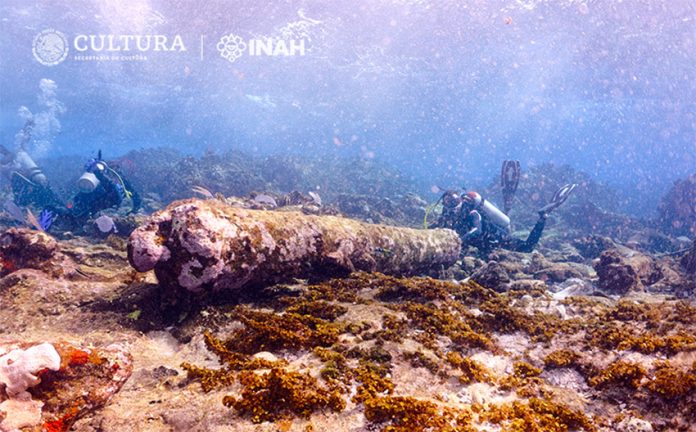Underwater archaeologists have rediscovered the remains of a sailing ship that is believed to have been wrecked off the coast of Quintana Roo in the late 18th or early 19th century.
Archaeologists with the National Institute of Anthropology and History (INAH) found the anchor and 2.5-meter-long cannon of what is believed to have been an English sailing ship at the southeastern corner of Banco Chinchorro, an atoll reef lying off the coast of the southern Quintana Roo municipality of Othón P. Blanco.
They also discovered pig iron ingots that are believed to have been used as ballast in the ship.
The wreck was first spotted by local fisherman Manuel Polanco, who took engineer and underwater archaeology enthusiast Peter Tattersfield to the site in the 1990s.
Tattersfield recently approached the underwater archaeology department of INAH and a team was put together to explore the more than 200-year-old shipwreck that has been named after Polanco, an octogenarian who is now retired.

The erstwhile fisherman and discoverer of several other shipwrecks is no longer able to go to sea because of his advanced age but his son, Benito Polanco, guided the INAH team to the site.
The archaeologists believe that the crew members made a last-ditch effort to save the ship by throwing the anchor overboard in an attempt to tether it to the atoll reef, INAH said in a statement on Tuesday.
They reached that conclusion because the anchor was completely integrated in the coral system of Banco Chinchorro, which has long been colloquially known as the quitasueños – nightmare or sleep-robbing – reef because of its treacherousness.
The “Manuel Polanco,” as the wreck is now known, is the 70th shipwreck to be documented by INAH archaeologists in the Banco Chinchorro natural reserve.
Laura Carrillo Márquez, an INAH archaeologist and head of the team that explored the wreck, said that a lot of details about the ship, such as its size and exact age, have not yet been determined because the site is in a “complex” location where there are strong currents.
However, further exploration is planned after the coronavirus restrictions are eased, she said.
Carrillo said the scientists haven’t found any of the wooden hull of the wrecked ship because it would have disintegrated over the hundreds of years it was left in the Caribbean sea water.
She said that the anchor and cannon were consistent with English designs from the 18th century but stressed that the hypothesis that the ship was British has not yet been confirmed.
Mexico News Daily
